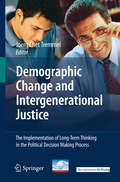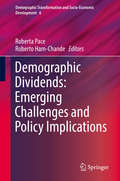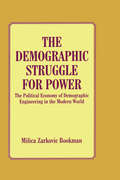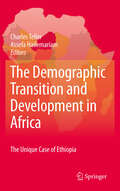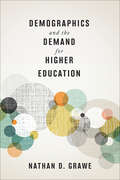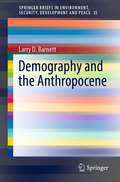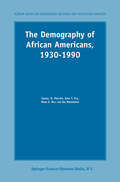- Table View
- List View
Demographic Change and Housing Wealth: Home-owners, Pensions and Asset-based Welfare in Europe
by John Doling Marja ElsingaAcross the EU, populations are shrinking and ageing. An increasing burden is being placed on a smaller working population to generate the taxes required for pensions and care costs. Welfare states are weakening in many countries and across Europe, households are being increasingly expected to plan for their retirement and future care needs within this risky environment. At the same time, the proportion of people buying their own home in most countries has risen, so that some two-thirds of European households now own their homes. Housing equity now considerably exceeds total European GDP. This book discusses questions like: to what extent might home ownership provide a potential cure for some of the consequences of ageing populations by realizing housing equity in order to meet the consumption needs of older people? What does this mean for patterns of inheritance and longer-term inequalities across Europe? And to what extent are governments banking on their citizens utilising their housing wealth now and in the future?
Demographic Change and Intergenerational Justice: The Implementation of Long-Term Thinking in the Political Decision Making Process
by Joerg TremmelIntergenerational justice has been achieved if the opportunities of the members of the next generation to fulfill their needs are better than those of the members of the preceding generation. For this, each generation ought to leave for the next generation an amount of resources is at least equal to its own amount. The book deals with the complex relationship between intergenerational justice and demographic change and is characterized by its interdisciplinary approach. The authors come from a multitude of professional backgrounds and from several countries. This illustrates the implications of the demographic shift from many different perspectives. The book deals not only with the aspects of economic policy but also with environmental, societal and philosophical issues. The comprehensive volume is composed of five sections that pinpoint demographic trends, examine the impact of demographic changes on key indicators, investigate the relationship between key indicators and intergenerational justice, scrutinize population policies, and finally propose ways to implement long-term thinking on these issues.
Demographic Change in Australia's Rural Landscapes: Implications for Society and the Environment (Landscape Series #12)
by Gary W. Luck Rosemary Black Digby RaceThe distribution and re-distribution of people across the landscape has signi cant implications for ecological, economic and social dynamics. Movement of people to urban centres (mostly from rural landscapes, especially in the developing world) is a major global phenomenon. This can result in the de-population of rural landscapes. Conversely, population growth and a changing demographic pro le have been id- ti ed for particular rural landscapes with notable examples from North America, Europe and Australia. Yet we know little of the factors that drive demographic changes in rural landscapes and even less about the implications of these changes. This book examines broad and local-scale patterns of demographic change in rural landscapes, identi es some of the drivers of these changes using Australian case studies or comparisons between Australian and international contexts, and outlines the implications of changes for society and the environment. This book makes a valuable contribution to the literature because it adopts an integrated and interdisciplinary approach by explicitly linking demographic change with environmental, land-use, social and economic factors. This integrated approach was achieved by encouraging interaction among authors writing on similar topics to ensure coherency and complementarity among chapters, and cross-pollination of ideas and perspectives. Chapters are presented as interactive and re ective d- cussions that address the ndings of other contributors; yet, each chapter contains enough background to stand alone as a unique contribution.
Demographic Change in Germany: The Economic and Fiscal Consequences
by Ingrid Hamm Helmut Seitz Martin WerdingThis book provides an up-to-date summary of the consequences of demographic aging for labor markets, financial markets, economic growth, social security schemes and public finances in Germany, essentially reflecting the present state of knowledge in any of these areas. All contributions are written by leading experts in their fields and are based on results that emerge at the forefront of current research.
Demographic Dividends: Emerging Challenges and Policy Implications (Demographic Transformation and Socio-Economic Development #6)
by Roberta Pace Roberto Ham-ChandeThis book examines potential economic opportunities that countries can experience when fertility rates fall and the average life expectancy of the working age population increases. It presents detailed demographic and economic analysis of middle-income countries throughout the world in order to show how these countries can take advantage of this demographic bonus. The book first traces the common link between policies that contribute to fertility transition as well as create the right kind of environment for reaping the benefit of demographic dividend. Next, it explores different countries and regions who are at different levels of development. It assesses the long term impact of gender equality on economic growth and development in Latin America; describes the life-cycle saving patterns of Mexican households; and examines demographic determinants of economic growth in BRICS. The book also offers demographic and economic analysis of the Mediterranean area, Sub-Saharan Africa, and New Zealand. The comparison between the different territorial contexts allow for the identification of three typologies of demographic dividend: the first dividend, when the working population grows faster than total population, the second dividend, as active generations get older and invest their savings in the production system of their country, and the third dividend, based on the coexistence of two populations age structure strongly contrasting. Overall, this book argues for the need to capitalize on the opportunities that come from the demographic dividend by investing heavily in education programs, training programs for the population working age, health programs, the creation of health insurance systems as well as programs to reduce or increase fertility levels.
Demographic Engineering: Population Strategies In Ethnic Conflict (International Population Studies)
by Paul MorlandDemography has always mattered in conflict, but with conflict increasingly of an inter-ethnic nature, with sharper demographic differences between ethnic groups and with the spread of democracy, numbers count in conflict now more than ever. This book argues for and develops a framework for demographic engineering which provides a fresh perspective for looking at political events in countries where ethnicity matters. It asks how policies have been framed and implemented to change the demography of ethnic groups on the ground in their own interests. It also examines how successful these policies have been, focusing on the cases of Sri Lanka, Israel/Palestine, Northern Ireland and the USA. Often these policies are hidden but author Paul Morland teases them out with skill both from the statistics and documentary records and through conversations with participants. Offering a new way of thinking about demographic engineering (’hard demography’ versus ’soft demography’) and how ethnic groups in conflict deploy demographic strategies, this book will have a broad appeal to demographers, geographers and political scientists.
Demographic Engineering: Population Strategies in Ethnic Conflict
by Paul MorlandDemography has always mattered in conflict, but with conflict increasingly of an inter-ethnic nature, with sharper demographic differences between ethnic groups and with the spread of democracy, numbers count in conflict now more than ever. This book argues for and develops a framework for demographic engineering which provides a fresh perspective for looking at political events in countries where ethnicity matters. It asks how policies have been framed and implemented to change the demography of ethnic groups on the ground in their own interests. It also examines how successful these policies have been, focusing on the cases of Sri Lanka, Israel/Palestine, Northern Ireland and the USA. Often these policies are hidden but author Paul Morland teases them out with skill both from the statistics and documentary records and through conversations with participants. Offering a new way of thinking about demographic engineering (’hard demography’ versus ’soft demography’) and how ethnic groups in conflict deploy demographic strategies, this book will have a broad appeal to demographers, geographers and political scientists.
Demographic Gaps in American Political Behavior
by Patrick FisherDemographic Gaps in American Political Behavior examines the political behavior of various groups in the United States in an effort to demonstrate how demographic backgrounds and socialization affect political behavior. Media coverage has disproportionately focused on the red state versus blue state divide, leaving the impression that American political behavior is determined solely by place of residence. This, however, ignores the numerous other political divides that exist in the United States today. In order to better conceptualize the landscape of American political behavior, Patrick Fisher analyzes the political gaps in six different demographics?income, religion, gender, race, age, and geography?and examines the effect these political gaps have on public opinion, policy, and party positioning. Written in an accessible fashion, Demographic Gaps in American Political Behavior uses contemporary examples and data from the 2008 and 2012 elections to help readers understand how and why demographic background has the potential to greatly influence political opinions and behavior.
Demographic Gaps in American Political Behavior
by Patrick FisherDemographic Gaps in American Political Behavior examines the political behavior of various groups in the United States in an effort to demonstrate how demographic backgrounds and socialization affect political behavior. Media coverage has disproportionately focused on the red state versus blue state divide, leaving the impression that American political behavior is determined solely by place of residence. This, however, ignores the numerous other political divides that exist in the United States today. In order to better conceptualize the landscape of American political behavior, Patrick Fisher analyzes the political gaps in six different demographics?income, religion, gender, race, age, and geography?and examines the effect these political gaps have on public opinion, policy, and party positioning. Written in an accessible fashion, Demographic Gaps in American Political Behavior uses contemporary examples and data from the 2008 and 2012 elections to help readers understand how and why demographic background has the potential to greatly influence political opinions and behavior.
The Demographic Masculinization of China: Hoping for a Son (INED Population Studies #1)
by Isabelle AttanéThis book describes the shortage of girls and women in present day China and focuses on two important features: the sex imbalance in childhood and youth, and the excess mortality of women at various stages of their life. The author analyzes the causes and the processes of a strong preference for sons, which generates discrimination toward females and results in a shortage of girls and women. China’s higher proportion of men than women is a population characteristic that is shared by very few countries in the world. This demographic masculinity is unprecedented in the documented history of human populations, both in scale and its lasting impact on the numbers and the structure of the population. Despite the economic boom of recent years, many families in China still consider girls to be less important than boys. Although Chinese women have become largely emancipated since the 1950s, they still do not have the same opportunities for social achievement as men, and Chinese society remains fundamentally rooted in highly gendered social and family roles. As a consequence, Chinese girl babies who have the misfortune to be born instead of a long-awaited son go by various names, such as Pandi (literally "awaiting a son"), Laidi ("a son will follow"), or Yehao ("she'll do too"). The book provides a comprehensive review of the situation of women in China’s society and shows that discrimination against girls and women is part of a system of norms and values that traditionally favours males.
Demographic Processes, Occupation and Technological Change: Symposium held at the University of Bamberg from 17th to 18th November 1989
by Ulrich Blum Josef SchmidThe Demographic Struggle for Power: The Political Economy of Demographic Engineering in the Modern World
by Milica Zarkovic BookmanThe 20th-century demographic struggle for power translates itself into an inter-ethnic war of numbers. This book offers suggestions for structural alterations within states to sever the link between ethnic size and power, and thus eliminate the rationale for the demographic struggle for power.
The Demographic Struggle for Power: The Political Economy of Demographic Engineering in the Modern World
by Milica Zarkovic BookmanThe 20th-century demographic struggle for power translates itself into an inter-ethnic war of numbers. This book offers suggestions for structural alterations within states to sever the link between ethnic size and power, and thus eliminate the rationale for the demographic struggle for power.
The Demographic Transition and Development in Africa: The Unique Case of Ethiopia
by Charles Teller"The heated Malthusian-Bosrupian debates still rage over consequences of high population growth, rapid urbanization, dense rural populations and young age structures in the face of drought, poverty, food insecurity, environmental degradation, climate change, instability and the global economic crisis. However, while facile generalizations about the lack of demographic change and lack of progress in meeting the MDGs in sub-Saharan Africa are commonplace, they are often misleading and belie the socio-cultural change that is occurring among a vanguard of more educated youth. Even within Ethiopia, the second largest country at the Crossroads of Africa and the Middle East, different narratives emerge from analysis of longitudinal, micro-level analysis as to how demographic change and responses are occurring, some more rapidly than others. The book compares Ethiopia with other Africa countries, and demonstrates the uniqueness of an African-type demographic transition: a combination of poverty-related negative factors (unemployment, disease, food insecurity) along with positive education, health and higher age-of-marriage trends that are pushing this ruggedly rural and land-locked population to accelerate the demographic transition and stay on track to meet most of the MDGs. This book takes great care with the challenges of inadequate data and weak analytical capacity to research this incipient transition, trying to unravel some of the complexities in this vulnerable Horn of Africa country: A slowly declining population growth rates with rapidly declining child mortality, very high chronic under-nutrition, already low urban fertility but still very high rural fertility; and high population-resource pressure along with rapidly growing small urban places”
Demographic Transition, Labour Markets and Regional Resilience (Advances in Spatial Science)
by Cristina Martinez Tamara Weyman Jouke Van DijkThis book discusses the question of how a regional economy can develop under the influence of an ageing and declining population, and how regional development policies can help make labor markets more resilient and more inclusive. As the greatest impacts of demographic change and policy and fiscal challenges can be observed at the local level, examples from European, North American and Asian regions are combined to present a comprehensive, global range of strategic solutions from different policy contexts. The book shows how institutions, organizations and communities can enhance their pathways for sustainable development through the intelligent management of their demographic transition, and offers a synthesis of valuable lessons and strategies.
Demographics and Innovation in the Asia-Pacific
by Karen Eggleston, Joon-Shik Park, and Gi-Wook ShinDemographic transition, along with the economic and geopolitical re-emergence of Asia, are two of the largest forces shaping the twenty-first century, but little is known about the implications for innovation. The countries of East Asia have some of the oldest age structures on the planet: between now and 2050, the population that is age 65 and older will increase to more than one in four Chinese, and to more than one in three Japanese and Koreans. Other economies with younger populations, like India, face the challenge of fully harnessing the "demographic dividend" from large cohorts in the working ages. This book delves into how such demographic changes shape the supply of innovation and the demand for specific kinds of innovation in the Asia-Pacific. Social scientists from Asia and the United States offer multidisciplinary perspectives from economics, demography, political science, sociology, and public policy; topics range from the macroeconomic effects of population age structure, to the microeconomics of technology and the labor force, to the broader implications for human well-being. Contributors analyze how demography shapes productivity and the labor supply of older workers, as well as explore the aging population as consumers of technologies and drivers of innovations to meet their own needs, as well as the political economy of spatial development, agglomeration economies, urban-rural contrasts, and differential geographies of aging.
Demographics and the Demand for Higher Education
by Nathan D. GraweHigher education faces a looming demographic storm. Decades-long patterns in fertility, migration, and immigration persistently nudge the country toward the Hispanic Southwest. As a result, the Northeast and Midwest;¢;‚¬;€?traditional higher education strongholds;¢;‚¬;€?expect to lose 5 percent of their college-aged populations between now and the mid-2020s. Furthermore, and in response to the Great Recession, child-bearing has plummeted. In 2026, when the front edge of this birth dearth reaches college campuses, the number of college-aged students will drop almost 15 percent in just 5 years.In Demographics and the Demand for Higher Education, Nathan D. Grawe has developed the Higher Education Demand Index (HEDI), which relies on data from the 2002 Education Longitudinal Study (ELS) to estimate the probability of college-going using basic demographic variables. Analyzing demand forecasts by institution type and rank while disaggregating by demographic groups, Grawe provides separate forecasts for two-year colleges, elite institutions, and everything in between. The future demand for college attendance, he argues, depends critically on institution type. While many schools face painful contractions, for example, demand for elite schools is expected to grow by more than 15 percent in future years.Essential for administrators and trustees who are responsible for recruitment, admissions, student support, tenure practices, facilities construction, and strategic planning, this book is a practical guide for navigating coming enrollment challenges.
Demographics and the Demand for Higher Education
by Nathan D. GraweHigher education faces a looming demographic storm. Decades-long patterns in fertility, migration, and immigration persistently nudge the country toward the Hispanic Southwest. As a result, the Northeast and Midwest;¢;‚¬;€?traditional higher education strongholds;¢;‚¬;€?expect to lose 5 percent of their college-aged populations between now and the mid-2020s. Furthermore, and in response to the Great Recession, child-bearing has plummeted. In 2026, when the front edge of this birth dearth reaches college campuses, the number of college-aged students will drop almost 15 percent in just 5 years.In Demographics and the Demand for Higher Education, Nathan D. Grawe has developed the Higher Education Demand Index (HEDI), which relies on data from the 2002 Education Longitudinal Study (ELS) to estimate the probability of college-going using basic demographic variables. Analyzing demand forecasts by institution type and rank while disaggregating by demographic groups, Grawe provides separate forecasts for two-year colleges, elite institutions, and everything in between. The future demand for college attendance, he argues, depends critically on institution type. While many schools face painful contractions, for example, demand for elite schools is expected to grow by more than 15 percent in future years.Essential for administrators and trustees who are responsible for recruitment, admissions, student support, tenure practices, facilities construction, and strategic planning, this book is a practical guide for navigating coming enrollment challenges.
Demographie als Herausforderung für den öffentlichen Sektor
by Reinhold Sackmann Bernadette Jonda Maria ReinholdDemographischer Wandel ist ein zentrales Zukunftsproblem. Vorhersagen prognostizieren dem öffentlichen Sektor aufgrund demographischer Entwicklungen eine Überalterung der Arbeitskräfte, Facharbeitermangel, verschlechternde Haushalte und eine allgemeine Einschränkung des öffentlichen Sektors. Aber werden diese dramatischen Konsequenzen wahr werden? Der Gegenstand des Buches sind soziale Antworten auf Probleme demographischer Alterung am Beispiel des Arbeitsmarktes des öffentlichen Sektors.
Demographischer Wandel in Unternehmen: Alternsgerechte Arbeitsbedingungen aus Arbeitnehmersicht
by Antje Schönwald Olaf Kühne Corinna Jenal Anna CurrinDer demographische Wandel verändert nahezu alle Lebensbereiche nachdrücklich. Besonders wirksam wird er in der Arbeitswelt. In der qualitativen wie quantitativen Studie werden Einflüsse auf die Arbeitsfähigkeit älterer Arbeitnehmer in saarländischen Industrieunternehmen aus der Perspektive der Arbeitnehmer selbst untersucht und dabei insbesondere die sogenannten weichen Faktoren wie Arbeitsklima, Zufriedenheit, Wohlbefinden, Partizipation oder Ansprüche an Führungskräfte, berücksichtigt. Damit richtet sich das Buch insbesondere an Personalverantwortliche, Betriebsräte, aber auch an WissenschaftlerInnnen, die sich mit dem demographischen Wandel, insbesondere in der Arbeitswelt, befassen.
Demographisierung des Gesellschaftlichen: Analysen und Debatten zur demographischen Zukunft Deutschlands
by Eva Barlösius Daniela SchiekZukunftsfähigkeit – hört man allerorten – hänge zuvörderst von der demographischen Lage ab. Folglich wird immer seltener über die Gesellschaft und vom sozialen Wandel berichtet und stattdessen vermehrt über die Bevölkerung informiert und eine Umkehr der demographischen Entwicklung angemahnt. Oft werden auf diese Weise soziale Phänomene zu demographischen Fakten erklärt: die Demographisierung des Gesellschaftlichen. Dieser Band will den Prozessen der Demographisierung nachspüren und fragt explizit auch nach den Chancen des demographischen Wandels.
Demography And Empire: A Guide To The Population History Of Spanish Central America, 1500-1821
by W. George LovellResearch on the Central American colonial experience-long overshadowed by the scholarly focus on Mexico and Peru-has begun to blossom, greatly expanding our knowledge of land and life in the region under Spanish rule. The first bibliography of its kind, Demography and Empire offers a comprehensive survey of recent literature in Spanish and i
Demography And Empire: A Guide To The Population History Of Spanish Central America, 1500-1821
by W. George LovellResearch on the Central American colonial experience-long overshadowed by the scholarly focus on Mexico and Peru-has begun to blossom, greatly expanding our knowledge of land and life in the region under Spanish rule. The first bibliography of its kind, Demography and Empire offers a comprehensive survey of recent literature in Spanish and i
Demography and the Anthropocene (SpringerBriefs in Environment, Security, Development and Peace #35)
by Larry D. BarnettEnvironmentalists devote little attention at the moment to the size and growth of the human population. To counter this neglect, the monograph (i) includes original graphs showing population size and growth since 1920 in the world as a whole and the United States; (ii) assembles evidence tying the increasing number of people to ecosystem deterioration and its societal consequences; and (iii) analyzes sample-survey data to ascertain whether the current disregard of population pressures by U.S. environmentalists reflects the thinking of Americans generally. However, even if a nation took steps primarily intended to lower childbearing and immigration, the findings of social science research indicate that the steps would not have a substantial, lasting impact. The discussion, which suggests an indirect way by which government may reduce fertility, underlines for environmental scholars the importance of studying their subject in a multidisciplinary, collaborative setting.
The Demography of African Americans 1930–1990 (The Springer Series on Demographic Methods and Population Analysis)
by S.H. Preston I.T. Elo Mark E. Hill Ira RosenwaikeThe authors of this work use a novel strategy that combines record linkage and demographic/statistical analysis to produce an internally consistent and robust set of estimates of the African-American population during the period 1930-1990. They interpret the record that emerges, with special reference to longevity trends and differentials. This work is for demographers, sociologists and students of ethnic studies.

